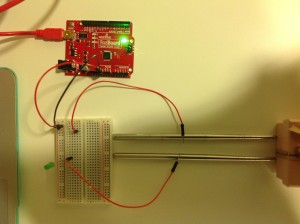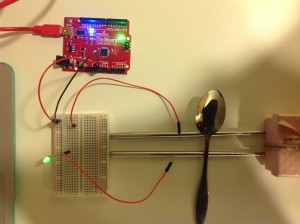In this project, I made a circuit with three digital inputs and three digital outputs. There are three switches with different colours and three different colours’ LED lights. Red and green switches together can control the blue LED lights, red and blue switches together control the green LED lights, and the blue and green switches control the red LED lights. If you push the three buttons at the same time, all lights will be on.
Author: Rong Sang
Tableware–Chopsticks and Spoon
My circuit which I only added chopsticks and a spoon into is quite simple. To make the light on, we only need to make sure that the voltage assigned to the light will be around its rated voltage. In addition, having a loop is quite important.
We can’t use common switch, so we’ll try something new. At first, I was going to find something which is made of metal that can conduct electricity. Then I chose my necklace and used it as conductor in my circuit, however, the light was still off and it didn’t work at all. Maybe the necklace has a quite large resistance, which leads to the light does not have enough voltage to be on. Or the necklace’s material does not have a good conductive in the circuit.
The second time, I chose nail clippers. When I cut it, I thought the top of the nail clippers can be closed to form a loop, maybe it can be a part of my circuits. Nevertheless, the light will always be on when I use the nail clippers as a connection.
The third time, I had a very simple idea by using chopsticks and spoon. Luckily, they naturally became a close circuit with GREAT conductive ability.
We don’t want to wait
I have to bring two objects every day when I’m in NYU Abu Dhabi. Guess! Books? Water? Sunscreen? No, they are ID Card and room card. We need to use ID Card to enter buildings and pay for our meals. The same, room card is used to enter our dorm, or you’ll enjoy a moment with public safety. It seems that we can not move normally without our cards.
Almost every day in the dining hall, there are two long lines of people waiting to pay for their meals. I am always imaging that can I pass the cashier in one second by using super power? You can see, the time to wait is relatively long when we are hungry.
Then I did an experiment at 7:00 P.M. in our East Dining Hall. I counted the number of people who finished paying and left cashier desk in one minute. The result shows that the average number is 3. It means if there are nine people in front of you, then you need to wait for three minutes. The time is not long, but can it be shorter? Or what can we do to shorten the time?
The process of paying is easy. Cashiers see what you bought, then input information to the machine, swipe your card and output. Compared with traditional trade in the street, we all have cards. The ways that people take them out are really different. I saw some people take their wallets and purses out of bags first, and then take their cards from them. Some people directly take out their cards in their pockets. Some people hold their wallets and purses with cards. After their paying, it seems there are many objects in their hands. The different ways of taking out cards sometimes costs different time. Besides, we are supposed to be polite and kind, we greets the cashiers we meet, it spends time. in addition, machines work more and more precise and smart, sometimes, the time increases. Interface changes from simply people to both people and machine, from one object to many.
Whether the easiest way to shorten the paying time is to simplify the process? Yes? No? I don’t have answer, but it is my question.


